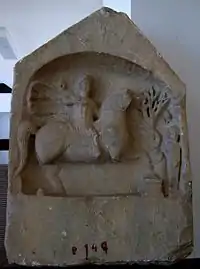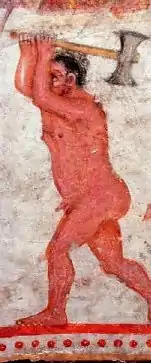Thracian religion
Thracian religion includes the religious practices of the Thracians. Little is known about their mythology and rituals, but some of their gods are depicted in statuary or described in Greek sources.

Cults
One notable cult, attested from Thrace to Moesia and Scythia Minor, is that of the "Thracian horseman", also known as the "Thracian Heros", at Odessos (Varna) attested by a Thracian name as Heros Karabazmos, a god of the underworld usually depicted on funeral statues as a horseman slaying a beast with a spear.[1][2][3]
Deities

Known Thracian deities include:
- Sabazios, the Thracian reflex of Indo-European Dyeus, identified with Heros Karabazmos, the "Thracian horseman". He gained a widespread importance especially after the Roman conquest. After Christianity was adopted, the symbolism of Heros continued as representations of Saint George slaying the dragon (compare Uastyrdzhi/Tetri Giorgi in the Caucasus).[2]
- Zibelthiurdos (also "Zbelsurdos", "Zibelthurdos"): a god recognized as similar to the Greek Zeus as a wielder of lightning and thunderbolts.
- Kotys ("Cotys", "Cotto", "Cottyto", "Cottytus"), a goddess worshipped with much revelry by Thracian tribes such as the Edonians in the festival Cotyttia.[6] A cult of Cottyto existed in classical Athens. According to Greek sources her priests were called baptes or "washers" because their pre-worship purification rites involved bathing. Her worship included midnight orgies (orgia). Her name is believed to have meant "war, slaughter", akin to Old Norse Höðr "war, slaughter".[7]
- Pleistoros, to which prisoners of war were sacrified.[8][9]
Several Thracian deities show close analogy to the Greek cult of Dionysus, Orpheus and Persephone (the Dionysian Mysteries):
- Bendis was a Thracian goddess of the moon and the hunt[10] whom the Greeks identified with Artemis, and hence with the other two aspects of formerly Minoan goddesses, Hecate and Persephone.
- Zemelā is probably a cognate of the Proto-Indo-European Earth goddess Dhéǵhōm, akin to Lithuanian Žemyna and Latvian Zemes Māte, both of which are "Mother Earth" goddesses.[11][12]
Known Dacian theonyms include:
- Zalmoxis, identified by some with the thunder-god Gebeleïzis,[13] an important god of the Dacians[14] and Thracians.[15]
- Derzelas (also "Darzalas") was a chthonic god of health and human spirit's vitality.
Kogaionon was the name of a holy mountain of the Dacians.
See also
| Wikimedia Commons has media related to Dacian and Dacians. |
Notes
- Lurker, Manfred (1987). Dictionary of Gods and Goddesses, Devils and Demons. p. 151.
- Nicoloff, Assen (1983). Bulgarian Folklore. p. 50.
- Isaac, Benjamin H. (1986). The Greek Settlements in Thrace Until the Macedonian Conquest. p. 257.
- Wagner, Hans (5 August 2004). "Die Thraker". Eurasisches Magazin (in German). Retrieved 19 January 2020.
- Dimitrov, Kalin (12 September 2008). "Thracian tomb of Aleksandrovo". Chain. Retrieved 19 January 2020.
- Detschew, Dimiter. Die Thrakische Sprachreste. Wien, 1957: p. 258 (in German)
- Also cognate: Irish cath "war, battle", early German Hader "quarrel", Greek kótos "hatred", Old Church Slavonic kotora "fight, brawl", Sanskrit śatru "enemy, nemesis", and Hittite kattu "spiteful". See Orel, Vladimir. A Handbook of Germanic Etymology. Leiden, Netherlands: Brill, 2003: 165.
- Pritchett, W. Kendrick (1974). The Greek State at War, Part V. University of California Press. p. 208. ISBN 978-0-520-07374-6.
- Isaac, Benjamin H. (1986). The Greek Settlements in Thrace Until the Macedonian Conquest. BRILL. p. 146. ISBN 978-90-04-06921-3.
- Theoi Project - Bendis
- West, M. L. (2007-05-24). Indo-European Poetry and Myth. OUP Oxford. pp. 174–175. ISBN 978-0-19-928075-9.
- Mallory, J. P.; Adams, Douglas Q. (1997). Encyclopedia of Indo-European Culture. Taylor & Francis. p. 174. ISBN 978-1-884964-98-5.
- Hdt. 4.94, Their belief in their immortality is as follows: they believe that they do not die, but that one who perishes goes to the deity Salmoxis, or Gebeleïzis, as some of them call him.
- Harry Thurston Peck, Harpers Dictionary of Classical Antiquities (1898),(Zalmoxis) or Zamolxis (Zamolxis). Said to have been so called from the bear's skin (zalmos) in which he was clothed as soon as he was born. He was, according to the story current among the Greeks on the Hellespont, a Getan, who had been a slave to Pythagoras in Samos, but was manumitted, and acquired not only great wealth, but large stores of knowledge from Pythagoras, and from the Egyptians, whom he visited in the course of his travels. He returned among the Getae, introducing the civilization and the religious ideas which he had gained, especially regarding the immortality of the soul. Herodotus, however, suspects that he was an indigenous Getan divinity ( Herod.iv. 95)
- XCV. This Zamolxis, as I have been informed by those Greeks who inhabit the Hellespont and the Euxine, was himself a man, and formerly lived at Samos, in the service of Pythagoras, son of Mnesarchus; having obtained his liberty, with considerable wealth, he returned to his country. Here he found the Thracians distinguished equally by their profligacy and their ignorance; whilst he himself had been accustomed to the Ionian mode of life, and to manners more polished than those of Thrace; he had also been connected with Pythagoras, one of the most celebrated philosophers of Greece. He was therefore induced to build a large mansion, to which he invited the most eminent of his fellow-citizens: he took the opportunity of the festive hour to assure them, that neither himself, his guests, nor any of their descendants, should ever die, but should be removed to a place, where they were to remain in the perpetual enjoyment of every blessing. After saying this, and conducting himself accordingly, he constructed a subterranean edifice: when it was completed, he withdrew himself from the sight of his countrymen, and resided for three years beneath the earth.—During this period, the Thracians regretted his loss, and lamented him as dead. In the fourth year he again appeared among them, and by this artifice gave the appearance of probability to what he had before asserted. XCVI. To this story of the subterraneous apartment, I do not give much credit, though I pretend not to dispute it; I am, however, very certain that Zamolxis must have lived Many years before Pythagoras : whether, therefore, he was a man, or the deity of the Getse, enough has been said concerning him. These Getse, using the ceremonies I have described, after submitting themselves to the Persians under Darius, followed his army. - Herodotus page 117 Published by P.P. Berresford, 1828
References
- Tacheva, Margarita. Eastern Cults in Moesia Inferior and Thracia (5th Century BC-4th Century AD), 1983, ISBN 90-04-06884-8.
